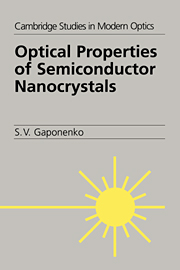Book contents
- Frontmatter
- Contents
- Preface
- 1 Electron states in crystal
- 2 Electron states in an ideal nanocrystal
- 3 Growth of nanocrystals
- 4 General properties of spectrally inhomogeneous media
- 5 Absorption and emission of light by semiconductor nanocrystals
- 6 Resonant optical nonlinearities and related many-body effects
- 7 Interface effects
- 8 Spatially organized ensembles of nanocrystals
- References
- Index
2 - Electron states in an ideal nanocrystal
Published online by Cambridge University Press: 09 October 2009
- Frontmatter
- Contents
- Preface
- 1 Electron states in crystal
- 2 Electron states in an ideal nanocrystal
- 3 Growth of nanocrystals
- 4 General properties of spectrally inhomogeneous media
- 5 Absorption and emission of light by semiconductor nanocrystals
- 6 Resonant optical nonlinearities and related many-body effects
- 7 Interface effects
- 8 Spatially organized ensembles of nanocrystals
- References
- Index
Summary
We consider an ideal nanocrystal to be a bit of a crystal with a spherical or cubic shape, the so-called quantum dot. Such species do not exist in nature. Nevertheless, it has been very helpful for the physics of nanocrystals to use these simplified models to trace the basic effects arising from three-dimensional spatial confinement. An extension of the effective mass approximation towards spatially confined structures leads to a particle-in-a-box problem and provides a way to calculate the properties of nanocrystals that are not possible to analyze in other way because of the very large number of atoms involved. This approach fostered the systematic experiments that have determined the major advances in nanocrystal physics. At smaller sizes it converges with the results of the quantum-chemical approach, in which the given number of atoms in the nanocrystal is accounted for explicitly rather than the size.
In this chapter we consider systematically the properties of electron-hole pair states resulting from the effective-mass consideration. We see that an elementary excitation in the electron subsystem of a nanocrystal can be classified as exciton with an extension “exciton in a quantum dot.” Afterwards, a survey of quantum-chemical techniques along with the selected examples for semiconductor clusters will be given. Finally, the distinctive size ranges will be outlined to specify the steps of the evolution of properties and of the applicability of the different approaches and concepts to the mesoscopic structures confined in all three dimensions.
- Type
- Chapter
- Information
- Optical Properties of Semiconductor Nanocrystals , pp. 27 - 54Publisher: Cambridge University PressPrint publication year: 1998
- 4
- Cited by



